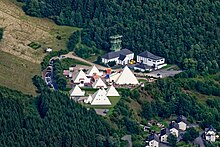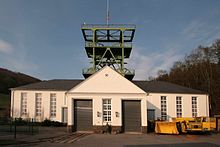Siciliaschacht mining museum
The Mining Museum Siciliaschacht is a mining museum in the Meggen district of Lennestadt . The former mining facilities of the Sachtleben company can be seen here .
history
Since the early 1850s was in the area of Meggen pyrites , especially necessary for the production of sulfuric acid , found in mountains. It was one of the earliest open and most important occurrences of this species in Germany. The company experienced an upswing primarily with the construction of the Lennetalbahn in the 1860s. Not only the chemical industry in Germany was dependent on this raw material, rather almost 2/3 of the production was at times exported. Some English mining companies even bought pits in the Meggen district . The development of cheaper Portuguese silica sulfur deposits ended the export boom and led the mining industry in Meggen and Halberbracht into a first crisis. The English mines were transferred to a newly founded company, which was named in 1879 under the name of the Siegena union, named after Siegen, where the main shareholders lived. In addition, as an amalgamation of smaller unions , the “Sicilia Union” came into being in the 1850s. Both companies were in constant competition with each other before they began to work together on various points in 1880.
With the upswing of the chemical industry during the founding years in Germany, sales opportunities improved significantly. In 1871 there were a total of 175 pits and 6 hereditary tunnels in the area. The great depression that began in the mid-1870s meant another economic setback, even if the company also began to mine heavy spar . It was only after 1900 that the sales of pebbles stabilized.
During this time, the company of the chemist Rudolf Sachtleben developed a process for the use of previously unusable remnants of the silica disulfide for the production of lithopones . For the factories operated by them , the pits in the Sauerland became the most important source of raw materials. Initially, Sachtleben only signed a cooperation agreement with the existing trade unions. In 1906 there was a merger with the Sigena trade union under the name “Trade Union Sachtleben” based in Homburg . In 1913 Sachtleben acquired the majority of the Kuxe of the Sicilia union from Count Landsberg von Velen and Gemen and other shareholders. Both unions remained independent legal entities but were in fact operated as one company. In the years before the First World War, the annual production was 150,000–200,000 t.
The pebble and barite mining around Meggen and Halberbracht experienced a significant boom in the First World War, precisely because of its importance to the war effort (in contrast to almost all other mining operations in the Sauerland). The workforce increased from 1,500 men in 1915 to almost 3,000 workers in 1918, and the production volume was 700,000 tons. During the Weimar Republic , Frankfurter Metallgesellschaft AG acquired part of the shares in both unions. With this financial support through the acquisition of smaller pits, they were able to combine the entire mining process in one hand. At the end of the 1920s, the Meggen mines were the leading barite and gravel pits in the world. The share in the world production of barite was 22% and the share in German pyrites production was 25%. The mines were also important to the war effort during the Second World War, and they experienced a further boom. In 1943 a total of over 4,000 workers, including many forced laborers and prisoners of war, were employed and an annual production of over 1 million t was achieved.
After the Second World War, rationalization measures resulted in massive staff cuts, but the mining industry remained efficient before it became clear in the late 1980s that the deposits were largely exhausted. Production was finally stopped in 1992.
museum
The shaft hall with two hoisting machines can be visited. In addition, there are informative tours by former miners who can report from their own experience.
Web links
Coordinates: 51 ° 7 ′ 42.5 ″ N , 8 ° 3 ′ 46.2 ″ E














